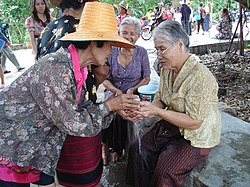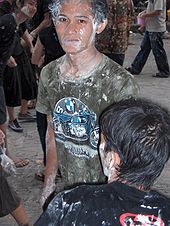Songkran (Thailand)
From Wikipedia, the free encyclopedia
| Songkran | |
|---|---|
 New Year celebration, Rot Nam Dam Hua, a traditional way to celebrate with elders. Most Thai people go back to their hometowns to meet their elders. |
|
| Official name | Songkran Festival (สงกรานต์) |
| Observed by | Thais |
| Significance | Marks the Thai New Year |
| Begins | 13 April |
| Ends | 15 April |
| Related to | Thingyan, Lao New Year, Cambodian New Year |
The date of the festival was originally set by astrological calculation, but it is now fixed. If these days fall on a weekend, the missed days off are taken on the weekdays immediately following. Songkran falls in the hottest time of the year in Thailand, at the end of the dry season. Until 1888 the Thai New Year was the beginning of the year in Thailand; thereafter 1 April was used until 1940. 1 January is now the beginning of the year. The traditional Thai New Year has been a national holiday since then.
Songkran has traditionally been celebrated as the New Year for many centuries, and is believed to have been adapted from an Indian festival. It is now observed nationwide, even in the far south. However, the most famous Songkran celebrations are still in the northern city of Chiang Mai, where it continues for six days and even longer. It has also become a party for foreigners and an additional reason for many to visit Thailand for immersion in another culture.
Contents[hide] |
[edit] New year traditions
| This section does not cite any references or sources. (April 2011) |
Besides the throwing of water, people celebrating Songkran as a Buddhist festival may also go to a wat (Buddhist monastery) to pray and give food to monks. They may also cleanse Buddha images from household shrines as well as Buddha images at monasteries by gently pouring water mixed with a Thai fragrance (Thai: น้ำอบไทย) over them. It is believed that doing this will bring good luck and prosperity for the New Year. In many cities, such as Chiang Mai, the Buddha images from all of the city's important monasteries are paraded through the streets so that people can toss water at them, ritually 'bathing' the images, as they pass by on ornately decorated floats. In northern Thailand, people may carry handfuls of sand to their neighborhood monastery in order to recompense the dirt that they have carried away on their feet during the rest of the year. The sand is then sculpted into stupa-shaped piles and decorated with colorful flags.
Some people make New Year resolutions - to refrain from bad behavior, or to do good things. Songkran is a time for cleaning and renewal. Besides washing household Buddha images, many Thais also take this opportunity to give their home a thorough cleaning.
Nowadays, the emphasis is on fun and water-throwing rather than on the festival's spiritual and religious aspects, which sometimes prompts complaints from traditionalists. In recent years there have been calls to moderate the festival to lessen the many alcohol-related road accidents as well as injuries attributed to extreme behavior such as water being thrown in the faces of traveling motorcyclists.
The water is meant as a symbol of washing all of the bad away and is sometimes filled with fragrant herbs when celebrated in the traditional manner.[2]
Songkran is also celebrated in many places with a pageant in which young women demonstrate their beauty and unique talents, as judged by the audience. The level of financial support usually determines the winner, since, to show your support you must purchase necklaces which you place on your chosen girl.
[edit] Astrological calculation
Although the traditional calendar of Thailand like most of Southeast Asia uses a lunisolar calendar, the date of the new year was calculated on a purely solar basis. The term Songkran comes from Sanskrit "Sankranta" and means "a move or change" — in this case the move of the sun into Aries — Mesha Sankranti.Chola Dynasty ruled Thailand during Rajendra Chola I's reign 1012–1044 C.E. Hence this festival coincides with the Tamil New Year, Puthandu, which follows the Nirayanam vernal equinox and generally falls either on 13 or 14 April of the Gregorian year. 13 or 14 April marks the first day of the traditional Tamil calendar and is a public holiday in both Tamil Nadu and Sri Lanka. Tropical vernal equinox falls around 22 March and, adding 23 degrees of trepidation or oscillation to it, we get the Hindu sidereal or Nirayana Mesha Sankranti (Sun's transition into Nirayana Aries). Hence, Songkran falls on the same date as observed by most traditional calendars in India as in Tamil Nadu, Assam, Bengal, Kerala, Manipur, Orissa, Punjab, Tripura etc. not to mention Nepal, Bangladesh, Burma, Cambodia, Laos and Sri Lanka.
[edit] Greetings
However, most people use "สุขสันต์วันสงกรานต์" (suk san wan songkran) — meaning "Happy Songkran Day" — since pi mai is more often linked with 1 January. Suk san is also used as an attribute for other days such as Valentine's Day ("สุขสันต์วันแห่งความรัก" suk san wan haeng khwam rak; Happy Valentine's Day).
[edit] In other calendars
Songkran is also celebrated in Laos (called pee mai lao), Cambodia (called Chaul Chnam Thmey, Cambodian New Year), Myanmar (called Thingyan သင်္ကြန်), and by the Dai people in Yunnan, China (called Water-Splashing Festival). The same day is celebrated in South Asian calendars as well: the Assamese (called Rongali Bihu), Bengali (called Pohela Boishakh), Oriya (called Maha Visuba Sankranthi), Malayali, Punjabi, Sinhalese, and Tamil New Years fall on the same dates, based on the astrological event of the sun beginning its northward journey. Songkran as such is similar to the Indian festival of Rangapanchami, Holi, with a lot of splashing of water as paints, colored dusts, and fragrances.The traditional new year celebration in Sri Lanka also coincides with the Thai new year.
In Nepal, the official new year is celebrated on the 1st of Baisakh (Baisākh) according to astrological calendar Vikram Samwat and day often falls somewhere between 12–15 April.
It occurs at the same time as that given by Bede for festivals of Eostre — and Easter weekend occasionally coincides with Songkran (most recently 1979, 1990, and 2001, but not again until 2085.[3])
| Wikimedia Commons has media related to: Songkran |
- Sankranti Indian Sub-Continent
- Puthandu
- Traditional new year celebration in Sri Lanka
- Pohela Boishakh – Bengali New Year (India's West Bengal and Tripura state and Bangladesh)
- Assamese New Year or Rongali Bihu (India's Assam state)
- Malayali New Year, or Vishu (India's Kerala state)
- Nepali New Year, or Bikram Samwat / Vaishak Ek (Nepal)
- Vishuva Sankranti-Oriya New Year (India's Orissa state)
- Lao New Year
- Cambodian New Year
- Burmese New Year
- Water Festival
- Qingming Festival
[edit] References
- ^ Saṃkrānti, Monier Williams Sanskrit-English Dictionary
- ^ http://www.thaiworldview.com/feast/songkran.htm
- ^ Ronald M. Mallen (April 2002). "Easter Dating Method". Astronomical Society of South Australia. Archived from the original on 20 March 2012. http://www.webcitation.org/66IwdCayT. Retrieved 20 March 2012. "List of Easter Sunday Dates 2000-2099"
View page ratings
Rate this page
Saved successfully
Your ratings have not been submitted yet
Your ratings have expired
Thanks! Your ratings have been saved.
An account will help you track your edits, get involved in discussions, and be a part of the community.
or
Thanks! Your ratings have been saved.
-->







ไม่มีความคิดเห็น:
แสดงความคิดเห็น